Many years ago. From a distance, the profile does look vaguely like of a tumulus but on close inspection I personally thought it seemed natural. But I'm far from an expert on these things. I agree that the name and location are very suggestive though.Paulus wrote:I'm intrigued!I see the place was also known as Bleak Lowe and it's right on the local boundary line. The word 'lowe' in our region is known to represent a meeting place (which'd make sense with it being on the boundary line), but also a tumulus. And dragons and tumuli have always gone together well! Have you had a wander into the few trees that remain in this little wood to see if owt's there?
Cross Lane did once refer to an old cross of some description. There's also a 14th Century building nearby called Highley Hall which used to be known as Crosse Hall. I've never specifically looked for any remains but I do recall reading - possibly in Pobjoy's history of the area - that it had been destroyed.Below Bleak Law Lane (or whatever it's new title) I see there was a Cross Lane. Any old cross-stump still there? And have y' found owt about the curiously-named 'Wagestan', possibly a 'stone that moves' - but certainly a stone of some sort in the adjacent parish.
As I originally understood it, Wagestan is just the old name for what's now called the Walton Cross (pictured on the blog post) and an Old English form of "way stone". It's a 10th Century Anglo-Saxon preaching cross close to Hartshead church on the same boundary line as Blakelaw.
However, thinking about it, it seems a bit odd that an decorated preaching cross which by all accounts stood 15 feet high as late as the 18th Century, should be prosaically referred to as a "way stone".
It seems the earliest mention is actually the foundation charter for Kirklees Priory and 19th Century antiquarians just assumed that Wagestan referred to the Walton Cross from the context, plus the fact that Walton could well be a corruption of Wagestan.
Investigating further, it seems that Walton is actually a pre-7th Century word of Brythonic origin meaning "farm in the wood" and quite common around Elmet. Hence, it's possible that actually the cross was named after the farm next to it, not the other way round, and that Wagestan could refer to another stone entirely.




